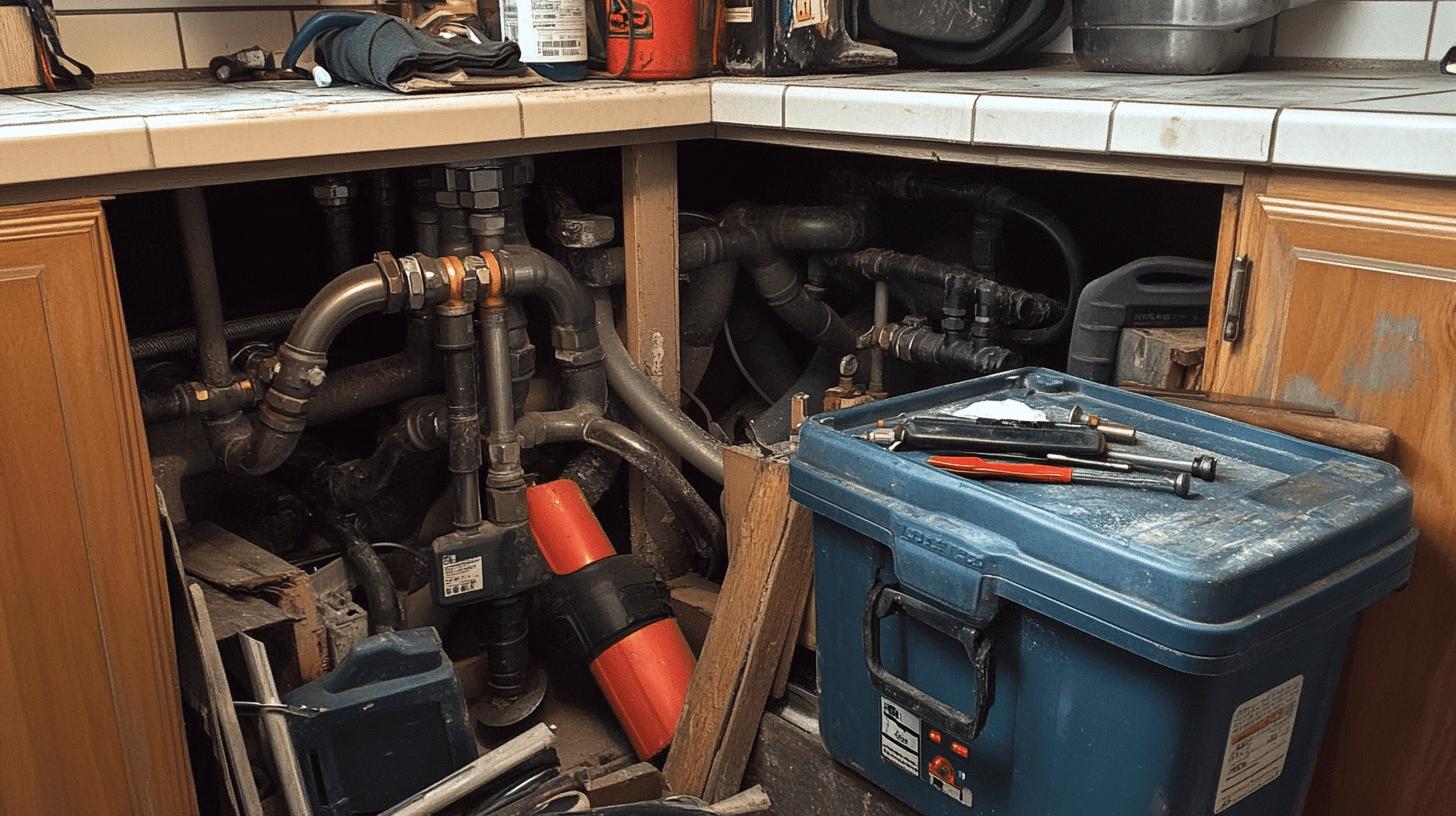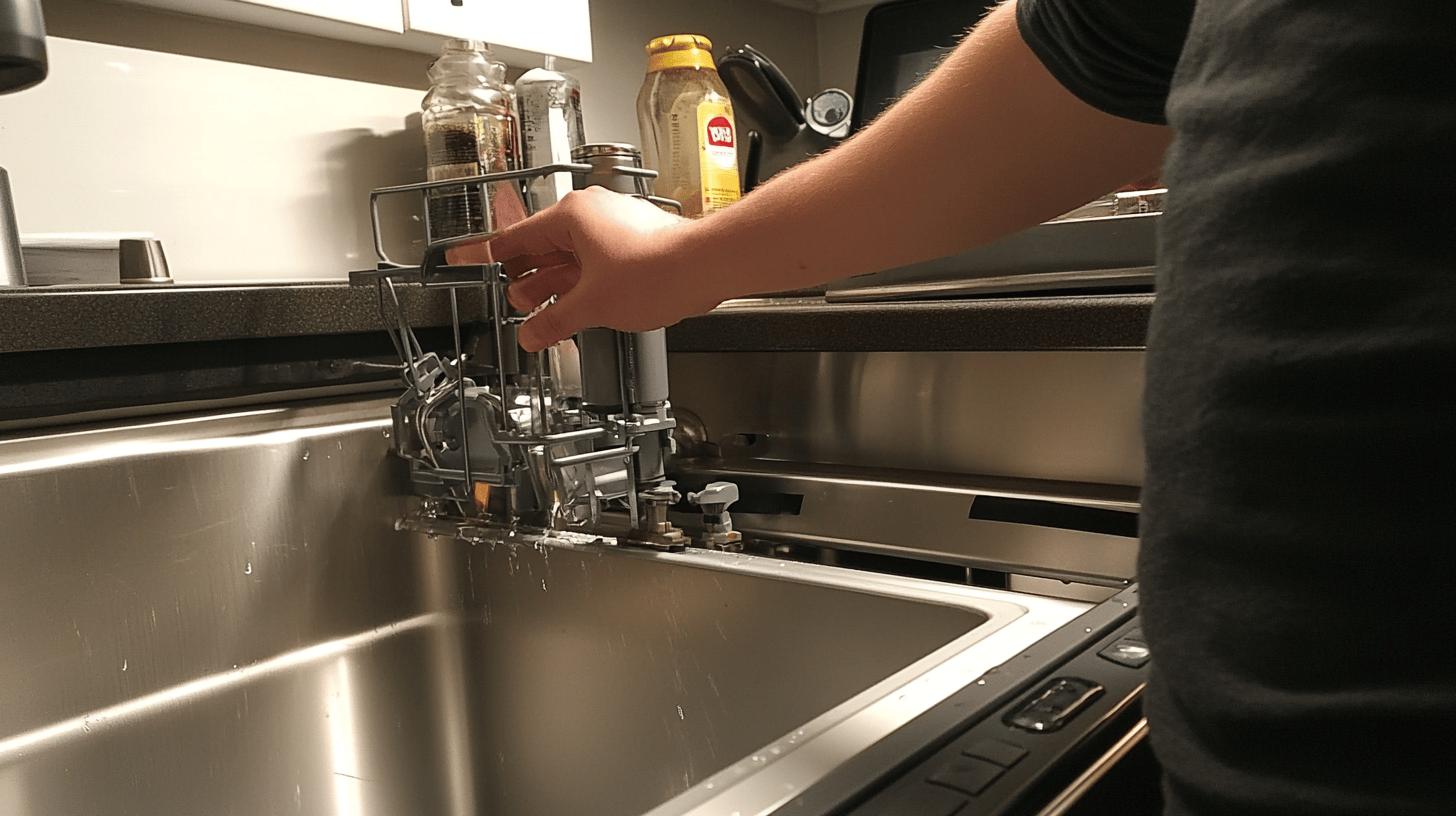TL;DR:
- Location: Dishwasher’s water supply valve is under the kitchen sink, connected to the cold water line.
- Identification: Look for a rubber hose and a valve (quarter-turn or multi-turn).
- Operation: Quarter-turn requires 90-degree rotation; multi-turn needs about two and a half turns.
- Emergency Steps: Close all valves under the sink if necessary and check for leaks.
- Common Issues: Leaks, difficulty turning, or failure to stop water flow; symptoms include inconsistent fill levels and strange noises.
- Maintenance: Check valves every six months for signs of corrosion or leaks.
- Professional Help: Recommended for replacements or persistent issues to ensure safety and compliance.
Have you ever had to deal with a water leak from your dishwasher? Knowing how to turn off the water supply is an essential skill that can help you avoid serious water damage in your kitchen. Whether you’re troubleshooting a problem or getting ready for a repair, it’s important to understand how to shut off the dishwasher’s water supply. In this guide, you’ll learn how to find and turn off the water supply to your dishwasher safely and effectively. By the end, you’ll have practical tips that will give you confidence in managing your kitchen plumbing.
Identifying Your Dishwasher’s Water Supply Valve
Knowing where your dishwasher’s water supply valve is located is key to preventing water damage. If there’s an emergency, shutting off the valve quickly can stop the water flow and save you from expensive repairs. You can usually find this valve under the kitchen sink, where it connects to the cold water supply.
- Under the Sink: Most often found here near the cold water line.
- Rubber Hose Connection: Look for the hose linked to the dishwasher.
- Washing Machine Valve: Often has a blue lever for identification.
- Quarter-turn Valve: Opens or closes with a simple 90-degree turn.
- Multi-turn Valve: Requires around two and a half full turns to operate.
Being able to visually identify these valves makes it easier to act quickly. A quarter-turn valve just needs a quick twist to shut off the water, while a multi-turn valve takes more effort to close. Knowing what type of valve you have is helpful during emergencies. If you’re not sure where the valve is or what type it is, it’s a good idea to ask a plumber for help.
Step-by-Step Guide to Turning Off the Water Supply to Your Dishwasher

Precision is vital in plumbing to avoid leaks and water damage. Follow these steps to safely turn off your dishwasher’s water supply:
-
Locate the Shut-Off Valve
Find the valve under the sink, linked to the cold water line and rubber hose on your dishwasher. -
Identify the Valve Type
Determine if it’s a quarter-turn or multi-turn valve. The former has a lever that moves 90 degrees, while the latter requires several turns. -
Turn Off the Valve
For a quarter-turn, rotate the lever 90 degrees clockwise. For a multi-turn valve, rotate it about two and a half turns clockwise to close.
-
Check for Secondary Valves
In emergencies, you might need to shut off all valves under the sink fully. -
Inspect the Hose Connection
After closing the valve, ensure no water leaks at the hose. A dry connection means it’s closed properly. -
Test the Dishwasher
Run a quick cycle to check if no water is entering, confirming the shut-off.
- Re-inspect for Leaks
Check for any leaks again. If found, tighten the valve or call a professional.
If unsure about any step, contacting a plumber is advisable. Their expertise keeps your plumbing safe from damage and you at ease.
Troubleshooting Common Issues with Dishwasher Shut-Off Valves
Issues with your dishwasher shut-off valve can be annoying and lead to damage if not addressed quickly. Common problems include leaks, difficulty turning the valve, or it not shutting off the water flow completely. You might notice drips from a leaking valve, while a valve that’s hard to turn could be corroded or clogged. If the valve is stuck, it could cause unwanted leaks.
Symptoms of a faulty water inlet valve often include:
- Inconsistent water fill levels
- No water entering
- Continuous dripping from the valve
- Poor cleaning due to low water
- Strange noises during operation
Temporary fixes, like tightening connections or using plumber’s tape, can help with minor leaks, but they aren’t long-term solutions. If you’re unsure about how to handle plumbing parts, it’s easy to make things worse. For ongoing issues or if you’re uncertain about the valve’s condition, it’s best to call a plumber. They can safely diagnose and fix the problem, making sure your dishwasher runs smoothly and is free from water damage.
Safety Precautions and Professional Recommendations

Regularly checking your dishwasher’s shut-off valve every six months is essential to avoid water damage. Look out for signs of corrosion, leaks, or difficulty turning the valve, as these issues might indicate it needs replacing. Catching problems early can save you from costly repairs down the line.
| Issue | Professional Solution |
|—————-|——————————————————-|
| Corrosion | Replace the valve to prevent leaks and ensure safety. |
| Leaks | Have a new valve installed by a licensed plumber. |
| Hard to Turn | Get the valve assessed and replaced if necessary. |
| No Water Flow | Diagnose and replace the faulty inlet valve. |
Replacing a faulty valve without the right knowledge can lead to more damage or even void warranties. Professional plumbers make sure the job is done according to local codes and safety standards. This not only fixes the problem but also helps your plumbing last longer.
Final Words
Knowing how to turn off the water supply to your dishwasher can save you a lot of money on repairs. By finding the shut-off valve, you can stop problems before they get worse. This step-by-step guide shows you how to properly turn off the water supply.
If you run into common valve issues, you might find some quick fixes, but getting a professional to handle repairs will give you peace of mind for the long run. Regular maintenance and expert advice are key to keeping valve problems at bay.
By taking these steps, you’ll protect your dishwasher and keep your kitchen safe.
FAQ
How to turn off water supply to dishwasher whirlpool?
To turn off the water supply, locate the valve under the sink and turn it clockwise. For quarter-turn valves, a 90-degree turn is sufficient, while multi-turn valves require about two and a half rotations.
No shut off valve for dishwasher?
If your dishwasher doesn’t have an independent shut-off valve, you may need to turn off the water supply to the entire sink. This is typically done by turning the hot or cold water valve clockwise until it stops.
How to turn off water supply to dishwasher bosch?
For a Bosch dishwasher, the water supply is typically turned off by locating the valve under the sink and turning it clockwise. It’s crucial to ensure the valve is fully closed to stop water flow.
Where is the water shut-off valve for a dishwasher?
The water shut-off valve for a dishwasher is typically under the kitchen sink. Look for a rubber hose connected to the cold water supply, often with a valve featuring a lever or knob.
How do I disconnect my dishwasher from the water supply?
First, locate and turn off the shut-off valve under the sink. Then, detach the water supply line from the valve using a wrench, taking care not to damage any fittings.
Do you need to turn off water to change the dishwasher?
Yes, it’s essential to turn off the water supply when changing a dishwasher to prevent leaks and possible water damage. Locate the shut-off valve under the sink and turn it clockwise.
What happens to dishwasher when water is turned off?
When the water supply to a dishwasher is turned off, it will not fill during the wash cycle. This prevents the dishwasher from running properly until the water is restored.

